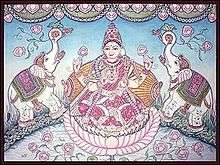Culture of Mysore
Mysore is a city in the state of Karnataka, India. It is known as the cultural capital of Karnataka.[1] Mysore was the capital of the Wodeyar kings who ruled over the Mysore Kingdom for many centuries. Wodeyars were great patrons of art and music and have contributed significantly to make Mysore a cultural centre.[2] Mysore is well known for its palaces, museums and art galleries and the festivities that take place here during the period of Dasara attract a worldwide audience. Mysore has also lent its name to popular dishes like Mysore Masala Dosa and Mysore Pak. Mysore is also the origin of the popular silk sari known as Mysore silk sari and has also given rise to a popular form of painting known as Mysore painting.
Festivals

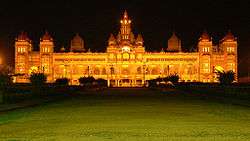
Dasara
Dasara is the Nadahabba (state-festival) of the state of Karnataka. It is also known as Navaratri (Nava-ratri = nine-nights) and is a 10-day festival with the last day being Vijayadashami, the most auspicious day of Dasara. Dasara usually falls in the month of September or October. According to a legend, Vijayadashami denotes the victory of truth over evil and was the day when the Hindu Goddess Chamundeshwari killed the demon Mahishasura. Mahishasura is the demon from whose name Mysore has been derived.
The Dasara festivities were first started by the Wodeyar King, Raja Wodeyar I (1578–1617 CE) in 1610.[3] The Mysore Palace is lit up on all the 10 days of Dasara. The festivities begin with the Wodeyar royal couple performing a special puja to Goddess Chamundeshwari in the Chamundi Temple located on the top of Chamundi Hill at Mysore. This would be followed by a special durbar (royal assembly).Kings wore the traditional Mysore Peta as headgear during the Durbar (court of Indian or princely state's kings) time or in a ceremonial procession during the Dasara celebrations. It was during the reign of Krishnaraja Wodeyar III in 1805, when the king started the tradition of having a special durbar in the Mysore Palace during Dasara; which was attended by members of the royal family, special invitees, officials and the masses. The King and men attending King's court wore the conventional attire called the durbar dress which comprised a black long coat with white trousers and a compulsory Mysore Peta. This tradition has been continued even now with the current scion of the Wodeyar family, Srikantadatta Narasimharaja Wodeyar holding a private durbar during Dasara. The ninth day of Dasara known as Mahanavami is also an auspicious day on which the royal sword is worshipped and is taken on a procession involving elephants, camels and horses.[4]
On Vijayadashami, the traditional Dasara procession (locally known as Jumboo Savari) is held on the streets of Mysore city. The main attraction of this procession is the idol of the Goddess Chamundeshwari which is placed on a golden mantapa on the top of a decorated elephant. This idol is worshipped by the royal couple and other invitees before it is taken around in the procession. Colourful tableaux, dance groups, music bands, decorated elephants, horses and camels form a part of the procession which starts from the Mysore Palace and culminates at a place called Bannimantap where the banni tree (Prosopis spicigera) is worshipped. According to a legend of the Mahabharata, banni tree was used by the Pandavas to hide their arms during their one-year period of Agnatavasa (living life incognito). Before undertaking any warfare, the kings traditionally worshipped this tree to help them emerge victorious in the war.[4] The Dasara festivities would culminate on the night of Vijayadashami with an event held in the grounds at Bannimantap called as Panjina Kavayatthu (torch-light parade).
Another major attraction during Dasara is the Dasara exhibition which is held in the exhibition grounds opposite to the Mysore Palace. This exhibition starts during Dasara and goes on till December. Various stalls which sell items like clothes, plastic items, kitchenware, cosmetics and eatables are set up and they attract a significant number of people. A play area containing attractions like ferris-wheel is also present to provide entertainment to the people. Various Governmental agencies setup stalls to signify the achievements and projects that they have undertaken.
On all the 10 days of Dasara, various music and dance concerts are held in auditoriums around Mysore city. Musicians and dance groups from all over India are invited to perform on this occasion. Another attraction during Dasara is the Kusti Spardhe (wrestling-bout) which attracts wrestlers from all around India.[5]
Palaces
Wodeyar kings of Mysore have built quite a few palaces in Mysore and this has earned the city the sobriquet of City of Palaces. Following are the palaces present here:
Ambavilas Palace
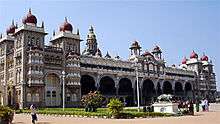


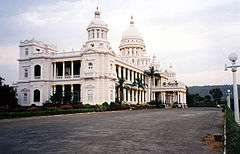

This is the main palace of Mysore and also termed as Mysore Palace. This palace was built in 1912 at a cost of Rs.4,150,000 in the Indo-Sarcenic style.[6] The earlier wooden palace that existed at this location got burnt in a fire during the wedding of Jayalakshammanni, the eldest daughter of Chamaraja Wodeyar, in February 1897.[7] The architect of this palace was Mr. Henry Irwin and the consulting engineer was Mr E W Fritchley.[6] The palace is a three storied structure with the tallest tower with a gilded dome rising to 145 feet above ground. In the first floor is the grand Durbar hall, where the kings used to hold their assembly. Some of the other important halls within the palace are Kalyana Mantap (the wedding hall), Gombe Thotti (hall of dolls) and Amba Vilasa (private hall). Lifelike paintings, murals, arms, trophies, stained glass windows and decorated domes enhance the architectural splendour of this palace.[7] This is the center of all festivities during the Dasara.
Jaganmohan Palace
Jaganmohan Palace was built in 1861 by Krishnaraja Wodeyar III in a predominantly Hindu style to serve as an alternate palace for the royal family. This palace housed the royal family when the older Mysore Palace was burnt down by a fire. The palace has three floors and has stained glass shutters and ventilators. It has housed the Sri Jayachamarajendra Art Gallery since the year 1915. The collections exhibited here include paintings from the famed Travancore ruler, Raja Ravi Varma, the Russian painter Svetoslav Roerich and many paintings of the Mysore painting style.[8] The Durbar Hall here was the place where the early convocations of the Mysore University were held. The hall also serves as an auditorium for staging cultural programmes.[7]
Jayalakshmi Vilas Mansion
This palace was built in 1905 by Chamaraja Wodeyar for his eldest daughter Jayalakshmi Devi. This mansion has three wings and contains a series of twin Corinthian and Ionic columns, regal pediments and oval ventilators. The mansion was originally built with a cost of Rs.700,000.[7] This mansion was acquired by the Mysore University to house its post-graduate campus. It was renovated in 2002 from funding provided by Infosys foundation.[9] The main hall in this mansion is the Kalyana Mantapa which has an eight-petal shaped dome with stained glass windows with a gold-plated Kalasha(tower) at the top. A new gallery called as Writer's Gallery has been created in the Kalyana Mantapa hall that will exhibit personal items, photographs, awards and writings of renowned writers of Kannada.[9] A special illumination system has also been added to this heritage structure. This mansion is said to be the first university museum complex in the country.[9]
Lalitha Mahal
The architect of this palace was Mr E W Fritchley. The palace was built by Krishnaraja Wodeyar IV in 1921 for the exclusive stay of the Viceroy of India. The palace is pure white in colour and is built in the style of Italian palazzo with twin Ionic columns and domes. It also has a sprawling terrace and landscaped gardens.[10] This palace has now been converted into a five-star hotel belonging to the Ashok Group of Hotels. The interior of this palace contains venation marble floors, rosewood furniture and a stately balustrade staircase. The central hall in the palace contains life size portraits of the royalty, lithographs, motifs, a Belgian glass dome and carved wood shutters. An ancient elevator, still in working condition, is also present.
Rajendra Vilas
This is a palace atop the Chamundi Hill. This was conceived in the 1920s and completed in 1938–1939. This was built as a summer palace for the Wodeyar kings. This palace is currently owned by the current scion of the royal family, Srikantadatta Narasimharaja Wodeyar. There are plans to convert this into a Heritage hotel.[11]
Cheluvamba Mansion
This mansion was built by Krishnaraja Wodeyar IV for his third daughter, Cheluvarajammanni. It now houses the CFTRI (Central Food and Technological Research Institute).
Painting
Mysore painting
The traditional form of painting called as Mysore painting is an offshoot of the Vijayanagar school of Painting. With the fall of the Vijayanagar empire, the artists who were involved in the Vijayanagar Paintings were rendered jobless. The Wodeyar king, Raja Wodeyar (1578–1617 CE) rehabilitated these artists in Srirangapatna and under his patronage, a new form of painting called as Mysore painting evolved.[12] These artists employed by the king made use of locally available materials to do the paintings. Squirell hair was used as a brush by tying the hair with a silken thread and inserting them into the narrow end of a quill. A cloth spread over a wooden plank formed the painting board. Properly burnt tamarind sticks were used as a sketching charcoal. The main attraction of these paintings was the gesso work in which gold foils were pasted on appropriate regions on the painting. Gesso was used for depicting intricate designs of clothes, jewellery and architectural details.[12] Stories from the Ramayana, Mahabharata, Bhagavata Purana and Jain epics formed the basis of these paintings. Mummadi Krishnaraja Wodeyar (Krishnaraja Wodeyar III) was instrumental in the growth of the Mysore painting form and is said to have commissioned more than 1000 portraits during his reign. Many of these paintings can still be seen on the walls of the Jaganmohan Palace at Mysore.[13]
Ganjifa Art
Ganjifa or Ganjeefa was a popular card game in ancient India. Played extensively in the Mughal period, Ganjifa is now known more for the art work on the cards than the game itself. Cards made for royalty were inlaid with precious stones and were also made of ivory, mother-of-pearl and wafers of lac. In Mysore, this game was known as "Chadd" (God's play).[14] One of the finest exponents of Ganjifa Art, Ganjifa Raghupathi Bhatta is a resident of Mysore and has set up an International Ganjifa Research Centre at Mysore. The cards are generally circular and sometimes rectangular in shape with lacquered backs with exquisite paintings on them..
Carpentry
Rosewood Inlay work
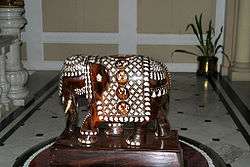
British writers mention the existence of thousands of workers in Mysore involved in inlaying etched ivory motifs into rosewood to create intricate wood work. Even now an estimated 4000 people in Mysore are involved in rosewood inlay work though other media like plastic have replaced ivory.[15] This intricate work involves many stages. The first step is to design and draw the images and patterns on the rosewood. Then the rosewood is cut into proper shape by carpentry. The motifs that have to be inlaid are then carefully handcut to shape. The areas where the motifs have to be inlaid on the rosewood, are carefully scooped out. Next the motifs are inlaid and fixed. The wood is then smoothened using sandpaper and polished to give a bright look.
Fashion
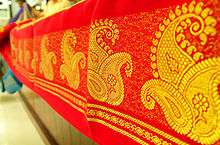
Mysore silk saree
Mysore is the home of the famous Indian feminine wear, the Mysore silk saree. Mysore Silk is a trademark for the silk sarees produced by KSIC (Karnataka Silk Industries Corporation).[16] The distinguishing feature of this saree is the usage of pure silk and 100% pure gold zari (a golden coloured thread containing 65% of silver and 0.65% of gold).[17] These sarees are manufactured in a silk factory located in Mysore city. This factory was started in 1912 by the Maharaja of Mysore by importing 32 looms from Switzerland. In 1980, this factory was transferred to KSIC and now has around 159 looms.[17] Every saree produced here comes with an embroidered code number and a hologram to prevent misuse. Mysore silk sarees are also undergoing an innovating change with the use of kasuti embroidery, thickly woven pallus (the part of the saree worn over the shoulder), bandhini techniques and new colours like lilac, coffee-brown and elephant-grey.[18]
Cuisine
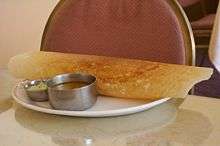
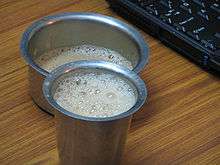
The cuisine of Mysore resembles to a large extent the Udupi cuisine. Rice is the staple food item used in cooking and various spices are also used. A breakfast mostly includes dishes made of rice of which idli and dosa are prevalent. Vada is another popular breakfast item mostly prepared only in hotels. Other popular breakfast dishes include shavige bath (spicy dish made of vermicelli), rava idli, oggarane avalakki (seasoned beaten rice), Pongal and Poori. A lunch or dinner spread generally includes steamed rice, chutney, sambar, pickle, curry, gojju (a sweet curry), rasam, papad and curds. Some of the rice based dishes that form a part of the lunch are Bisi bele bath (a spicy rice preparation with vegetables), vangi baath (rice mixed with brinjal curry), chitranna (rice mixed with seasoning, turmeric and lemon juice or raw mango scrapes) and Puliyogare. Chapati is another lunch item preferred nowadays. In formal occasions like marriage, the food is served on a plantain leaf and would include additional items like sweets and Kosambari apart from the ones mentioned above. Some of the popular sweet dishes are rave unde (sweet balls made of semolina and coconut scrapes), ladoo, payasam, Mysore Pak and jalebi. It is customary to eat adike (arecanut) with betel leaf after the lunch/dinner. Coffee (Indian filter coffee) is the preferred beverage in homes. Some of the snacks that are prevalent here are chakkuli, khara mandakki (spicy puffed rice), churmuri and kodubale (a doughnut shaped spicy snack made of fried semolina). In the last few years, chaat, pizzas and items belonging to Indian Chinese cuisine have become popular mostly with the younger generation. Mysore has also lent its name to the sweet-dish Mysore Pak and the Mysore Masala Dosa.
Institutions
CAVA
Chamarajendra Academy of Visual Arts (CAVA) is an arts academy located in Mysore and affiliated to the University of Mysore. It offers courses in drawing, painting, sculpture, graphics, applied arts, photography, photojournalism and art history. It awards the Bachelor of Fine Arts degree and also has a master's program leading into the Master of Fine Arts. It was started in 1906 as Chamarajendra Technical Institute by the then King of Mysore, Nalvadi Krishnaraja Wodeyar. King George V laid the foundation to this institute which was started in dedication to the king, Chamarajendra Wodeyar. Chamarajendra Technical Institute was renamed as CAVA in 1981 by the Government of Karnataka and on the suggestions of the renowned Russian painter, Svetoslav Roerich, CAVA was modelled on the lines of the famous J.J. School of Arts in Mumbai.
Rangayana
Rangayana is a theatre institution located in the campus of Kalamandira auditorium in Mysore. It was started in 1989 as an autonomous cultural organisation by the Government of Karnataka. It has two divisions working under it, Bharatiya Ranga Shikshana Kendra which is a theatre training institute and Sriranga Ranga Mahiti and Samshodana Kendra which is a documentation and research centre. Having an ensemble of fifteen actors and actresses, Rangayana Repertory performs on week ends (Saturday & Sunday) at Bhoomigita Theater at Mysore. It also offers a 1-year diploma course for theatre enthusiasts.[19]
Dhvanyaloka
Dhvanyaloka is an institution dedicated to the advanced study and research in English literature. It was started in 1979 by Prof. C. D. Narasimhaiah (popularly known as CDN). This institution publishes a journal called as Literary Criterion which contains articles related to literature. Some of the other books published by this institution includes Kipling's India, Bhakti in Indian literature, Indian poetics in application, Western writers on India, the Vitality of West Indian Writing, Glimpses of New Zealand Literature, T. S. Eliot and the Indian Literary Scene and Indian literature in English
Museums
The following museums exist in Mysore:
- Regional Museum of Natural History: This museum is located on the banks of the Karanji lake in Mysore and has exhibits related to biological diversity, ecology and geology of Southern India.[20]
- Folk Lore Museum: This museum is located in the University of Mysore campus and exhibits over 6500 folk art and crafts from all over the state of Karnataka.[21]
- Rail Museum: This museum is located near the Mysore Railway station and is the second one of its kind established in India after the one at Delhi. This museum exhibits ancient locomotives and carriages some of which are still in working condition. Photographs and books related to railway are also present.[22]
- Oriental Research Institute, formerly known as the Oriental Library, established in 1891 contains over 33000 palm leaf manuscripts
- Melody World Wax Museum, This one of its kind wax museum on musicians and musical instruments is located in Siddhartha Layout, on the way to Chamundi Hills.
Personalities
Drama
- Hirannaiah: Mysore has given to the Kannada theatre world; one of its stalwarts in the form of Senior Hirannaiah, the father of the well known dramatist and comedian, Master Hirannaiah. Hirannaiah was born in Mysore in 1905. He has produced some of the famous Kannada dramas like Devadasi, Sadaarame and Yechamma Nayaka. His drama Sadaarame is said to have run at full house in the Town Hall at Mysore for a continuous 48 days. Also his drama Devadasi set a record run of being played for a continuous five months. He was also the founder member of the drama troupe called Mithra Mandali. For his contribution to the field of drama, he received the title of Cultural Comedian from the Mysore king. He died on 21 March 1953. One of his famous quotes says, Drama is the best type of art and the worst type of profession.[23]
- B. V. Karanth: B. V. Karanth is an alumnus of the National School of Drama who also later became its director. He has directed many Kannada plays and movies. His movie Chomana Dudi (Choma's drum) has won the National Award for the Best Film. His contribution has been recognised by the Government of India who awarded him the Padma Shri award. His association with Mysore was from the year 1989–1995 when he was the director of Rangayana, the famous theatre institution at Mysore.
Literature

- Kuvempu: Kuvempu is a Kannada writer, poet of 20th century widely regarded as the greatest writer of Kannada language. He is one of the recipients of the Jnanpith award and has a long association with Mysore. He came to Mysore for his higher education and joined Maharaja College of Mysore where he graduated in 1929 majoring in Kannada. After his graduation, he continued as a lecturer of Kannada in Maharaja's college. After a brief stint in Bangalore, he rejoined Maharaja's college as a Kannada professor in 1946 and later went on to become its principal in 1955. In 1956, he was elected as the Vice-Chancellor of Mysore University where he served till retirement in 1960. Kuvempu is the one who christened the Mysore University campus as Manasagangotri. It is said that Kuvempu used to frequently walk on the periphery of the Kukkarahally Lake in Mysore; which was a source of inspiration for him.[24] Kuvempu died in Mysore in 1994.
- R.K. Narayan: R.K. Narayan is one of the best known English novelist from India. Most of his writings are based on a fictional Indian town called Malgudi. Narayan spent most of his life in Mysore where his father was the headmaster of Maharaja's High School. He has a Bachelor of Arts degree from University of Mysore. His first published novel was Swami and Friends. Though Narayan faced hurdles while publishing this novel, he was able to succeed in publishing it with the help of Graham Greene.[25] Some of his other famous novels are The Guide, The Man-Eater of Malgudi, The English Teacher and The World of Nagaraj. The Guide was made into a very famous Hindi film and this also earned him the National Award from Sahitya Akademi. Most of his short stories related to Malgudi have been made a part of a tele serial called as Malgudi Days which was directed by Shankar Nag. The Government of India has awarded him the Padma Vibhushan for his contribution to the English Literature. Some of the characters in his novels, like Raju (in The Guide), Sampath (in Mr. Sampath - The Printer of Malgudi) and Margayya (in The Financial Expert) are said to be real life Mysoreans.[26] Naryan's younger brother R. K. Laxman is a well known cartoonist.
- R. K. Laxman: R. K. Laxman is the younger brother of R.K. Narayan and is a well known cartoonist. He was born in Mysore in 1924. His most famous cartoon creation is that of The Common Man. He graduated from the University of Mysore. He drew illustrations for his brother Narayan's stories in The Hindu. Later, he joined The Times of India; an association that continued for over fifty years. Laxman is best known for his daily one panel comic "pocket cartoon" series published daily in The Times of India called You Said It; which features The Common Man; and chronicles the state of Indian life. The Government of India has awarded him the Padma Vibhushan award.
- Gopalakrishna Adiga: Gopalakrishna Adiga was one of the father's of Modern Kannada poetry. He is known as the pioneer of the Kannada New style form of poetry[27] and was part of a trinity of great modern Kannada poets along with Kuvempu and Shivaram Karanth.[28] He did his higher education in Mysore where he earned his Master's degree in English literature from Mysore University and was also a recipient of the BMS Gold Medal for Poetry awarded by that University. In the 1950s and 1960s, Adiga was a teacher of English literature in Mysore.
- U R Ananthamurthy: Ananthamurthy is a leading contemporary writer, critic and philosopher in Kannada language. He is a recipient of the Jnanpith award. He has a Master of Arts degree from the Mysore University and he also started his career as a professor and instructor of English in this university. Ananthamurthy made Mysore his home for a number of years before moving to Bangalore.
Music
The Mysore brothers, Dr. Mysore Manjunath and Mysore Nagaraj, are world-renowned violin maestros from the city of Mysore; sons of veteran musician Sangita Vidya Nidhi Vidwan Mahadevappa, the brothers' outstanding musicianship and astounding virtuosity made them some of the best violin players in the contemporary music world. They represent the genre of Carnatic music and have collaborated with numerous world-class musicians in countless countries at major music festivals and conferences.
Mysore also boasts of one of the finest violin teachers of India H. K. Narasimhamurthy. He has trained a long line of students, who have gone onto make a mark in the world of Indian music. A highly regarded accompanist, H.K.N.Murthy has accompanied most of the leading Carnatic musicians in a career spanning more than 5 decades. His students, some of who are acclaimed to be world class in India and the west, have gone on to play in Carnegie Hall, Lincoln Center, Sydney Opera house and Madras Music academy among other venues. Some of his leading disciples who are professional musicians include his son H. N. Bhaskar, Mysore Srikanth, Mysore Dayakar and H. M. Smitha.
Mysore has to its credit many renowned musicians like Raghu Dixit and Vijay Prakash to name a few. Mysore even witnessed a musical fight against corruption in January 2012 when a song called 'Alarm – wake up guys' was released. The music for the song was composed by a young Mysorean named Phalgunn Maharishi and Kannada lyrics were written by Suraj Shankar, who also hails from Mysore. They are the grandsons of a noted novelist from Mysore, Mrs. Mangala Satyan. Their hard work was appreciated by many people when the song was premiered by TV9 Karnataka and many newspapers wrote about the two cousins and their work on Alarm.
See also
| Wikimedia Commons has media related to Culture of Mysore. |
Notes
- ↑ The Correspondent. "Goodbye to old traditions in 'cultural capital'". Online Edition of The Deccan Herald, dated 2006-03-17. 2005, The Printers (Mysore) Private Ltd. Archived from the original on 5 February 2007. Retrieved 2007-04-04.
- ↑ Contribution of Wodeyar kings to the art and culture of Mysore city is discussed by Shankar Bennur. "Dasara on canvas". Online Edition of The Deccan Herald, dated 2006-09-26. 2005, The Printers (Mysore) Private Ltd. Retrieved 2007-04-04.
- ↑ Detailed account of the Dasara festival celebrated at Mysore is provided by Ravi Sharma. "Mysore Dasara: A historic festival". Online Edition of The Frontline, Volume 22 – Issue 21, dated 2005-10-08:2005-10-21. 2005, Frontline. Retrieved 2007-04-04.
- 1 2 Detailed account of the Mysore Dasara festival is provided by Prabuddha Bharata. "Mysore Dasara – A Living Tradition". Webpage of eSamskriti.com. Shri Sanjeev Nayyar. Archived from the original on 7 March 2007. Retrieved 2007-04-04.
- ↑ Details regarding Dasara Wrestling competition held in Mysore is provided by Shankar Bennur. "Dasara wrestling to offer 'thunder' bouts". Online Edition of The Deccan Herald, dated 2005-09-30. 2005, The Printers (Mysore) Private Ltd. Retrieved 2007-04-04.
- 1 2 Shankar Bennur. "Of monumental value". Online Edition of The Deccan Herald, dated 2005-04-19. Copyright 2005, The Printers (Mysore) Private Ltd. Archived from the original on 4 February 2007. Retrieved 2007-04-10.
- 1 2 3 4 Detailed description of the palaces in Mysore is provided by "Palaces of Mysore". Online Webpage of MysoreSamachar.com. MysoreSamachar.com. Retrieved 2007-04-10.
- ↑ A brief description about Jaganmohana Palace is provided by National Informatics Centre. "JaganMohana Palace". Official website of the Mysore District. District Administration, Mysore. Retrieved 2007-04-11.
- 1 2 3 A description about Jayalakshmi Vilas Mansion is provided by R. Krishna Kumar (24 July 2006). "It is a real treasure trove". Online Edition of The Hindu, dated 2006-07-24. Chennai, India: 2006, The Hindu. Retrieved 2007-04-11.
- ↑ Profile of the Lalitha Mahal is provided by "Lalitha Mahal Palace Hotel". Online Webpage of Lalitha Mahal Palace Hotel. 2003–2004 Lalitha Mahal Palace Hotel. Retrieved 2007-04-11.
- ↑ Restoration work at Rajendra Vilas Palace is discussed by R. Krishna Kumar (18 August 2005). "Looking beyond the heritage tag". Online Webpage of The Hindu, 2005-08-18. Chennai, India: 2005, the Hindu. Retrieved 2007-04-11.
- 1 2 A detailed account of the traditional form of Mysore painting is provided in "Mysore Painting" (PDF). Online Website:IndianFolkLore.org. National Folklore Support Centre. Archived from the original (PDF) on 28 September 2007. Retrieved 2007-04-05. External link in
|work=(help) - ↑ A brief description the traditional Mysore Painting is provided by K. L. Kamat. "Mysore Traditional Paintings – An Introduction". Webpage of Kamat's Potpourri. Kamat's Potpourri. Retrieved 2007-04-05.
- ↑ An account on Ganjifa is provided by Correspondent. "Patent for Ganjifa Playing Cards". Webpage of OurKarnataka.com. Star of Mysore. Archived from the original on 15 May 2007. Retrieved 2007-04-05.
- ↑ An article on Rosewood inlay work is provided by Pushpa Chari (30 May 2002). "Intricate Patterns". Online Edition of The Hindu, dated 2002-05-30. Chennai, India: 2002, The Hindu. Retrieved 2007-04-05.
- ↑ Trademark for Mysore Silk is obtained by KSIC reports Bureau. "Mysore Silk gets geographical indication". Online Edition of The Hindu Business Line, dated 2005-12-17. 2005, The Hindu. Retrieved 2007-04-09.
- 1 2 Details regarding Mysore silk is provided by "Mysore – Silk weaving & Printing silk products". Online Webpage of KSIC. Karnataka Silk Industries Corporation. Archived from the original on 24 July 2011. Retrieved 2007-04-09.
- ↑ Innovation in Mysore silk saree is mentioned by Aruna Chandaraju. "Modern MYSURU". Online Webpage of The Hindu, dated 2005-03-05. 2005, The Hindu. Retrieved 2007-04-22.
- ↑ A brief profile of Rangayana is presented by "About Rangayana". Online webpage of Rangayana, Rangayana.org. Rangayana. Retrieved 2007-04-06.
- ↑ An overview of the Regional Museum of Natural History is provided by National Informatics Centre. "Regional Museum of Natural History, Mysore". Online Webpage of National Museum of Natural History. Ministry of Environment and Forests, Government of India. Retrieved 2007-04-10.
- ↑ An overview of the Folk Lore Museum is provided by "Mysore". Online Webpage of Karnataka Tourism Department. Tourism Department, Government of Karnataka. Archived from the original on 28 February 2007. Retrieved 2007-04-10.
- ↑ An overview of the Rail Museum is provided by Staff Correspondent (3 June 2004). "Mysore Rail Museum celebrates silver jubilee". Online Edition of The Hindu, dated 2004-06-03. Chennai, India: 2004, The Hindu. Retrieved 2007-04-10.
- ↑ Veena Bharathi. "Blessed with the gift of the gab". Online Edition of The Deccan Herald, dated 2005-05-08. 2005, The Printers (Mysore) Private Ltd. Archived from the original on 11 September 2006. Retrieved 2007-04-06.
- ↑ Kukkarahally Lake was a source of inspiration for Kuvempu is mentioned by Special Correspondent (30 January 2007). "On how to boost Mysore's tourism". Online Edition of the Hindu, dated 2007-01-20. Chennai, India: 2007, The Hindu. Retrieved 2007-04-09.
- ↑ A detailed article on R K Narayan has been written by N Ram. "Malgudi's Creator". Online Edition of the Frontline, Volume 18 – Issue 11, May 26 – June 8, 2001. 2001, Frontline. Retrieved 2007-04-09.
- ↑ That some of the characters in Narayan's novels were real life Mysoreans is mentioned by Special Correspondent (12 October 2006). "Narayan's Mysore connection". Online Edition of The Hindu, dated 2006-10-12. Chennai, India: 2006, The Hindu. Retrieved 2007-04-09.
- ↑ Gopalakrishna Adiga was a pioneer of the Navya style of Kannada poetry is mentioned by K. Chandramouli. "Lyrical Land". Online Edition of The Hindu, dated 2002-08-26. 2002, The Hindu. Retrieved 2007-04-09.
- ↑ Trinity of Gopalakrishna Adiga, Kuvempu and Shivaram Karanth is mentioned by Staff Reporter. "Gopalakrishna Adiga remembered". Online Edition of The Hindu, dated 2004-10-04. Retrieved 2007-04-09.
